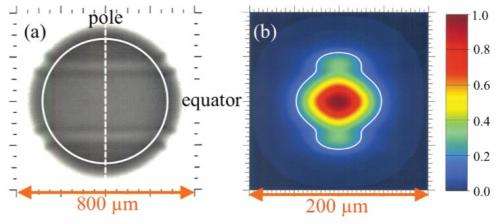Studying effects of target 'tents' on NIF

A systematic study of the effects on National Ignition Facility (NIF) implosions of the ultra-thin mounting membranes that support target capsules inside NIF hohlraums was reported by LLNL researchers in a Physics of Plasmas paper, (link is external) published online Feb. 4.
The performance of NIF's inertial confinement fusion targets depends on the symmetric implosion of highly compressed fuel. The target capsule is held at the center of the hohlraum by two plastic membranes called tents. On early NIF shots, the tent membrane was 300 nanometers (nm) thick; as technology improved, targets were built with 110-nm, 45-nm, 30-nm, and most recently as thin as 12-nm tents (as the tent becomes thinner it becomes less reliable as a support).
Because the mounting membranes are so thin, it was originally estimated that the tent would have acceptable impact on the implosion. The researchers found, however, that in low adiabat (high convergence) implosions, the tent seeds a perturbation at its liftoff position, which leads to Rayleigh-Taylor hydrodynamic instabilities (RTIs) that can affect the symmetry and reduce the yield of NIF implosions.
The researchers used X-ray area-backlit imaging to assess in-flight low-mode (long-wavelength) 2D asymmetries of the shell. They said these time-resolved images reveal features that can be related to the liftoff position of the membranes. "Simulations with a tent-like feature normalized to match the feature seen in backlit images predict a very large impact on the capsule performance from the tent feature," researchers said.
The experimental data suggest that in the low adiabat (high convergence) implosions, the tents seed hydrodynamic instabilities at the capsule surface from the beginning, which grow throughout the implosion until they eventually come close to perforating the capsule. On the other hand, in higher-adiabat shots (shots with higher internal energy, making for lower density at the same pressure) – such as the recent, record-setting "high-foot" NIF experiments with higher initial laser pulses – the impact of the tent is significantly reduced due to the overall reduction of hydrodynamic instability in these implosions.
"Simulated high-adiabat implosions seeded with a similar (perturbation) do not show any visible feature in a radiograph image," the researchers reported. "The tent feature is not predicted to have a significant effect on the performance of these high-adiabat implosions, consistent with their reduced hydrodynamic instability.
"This work shows," researchers said, "that it is important to use mounting membranes that are as thin as possible, find mitigation strategies, for example, in the form of the laser pulse shapes for less instability growth, or alternative mounting strategies, and to keep this tent effect in mind when interpreting results of self-emission shape measurements."
More information: "Effect of the mounting membrane on shape in inertial confinement fusion implosions" Phys. Plasmas 22, 022704 (2015); dx.doi.org/10.1063/1.4907179
Journal information: Physics of Plasmas
Provided by Lawrence Livermore National Laboratory





















